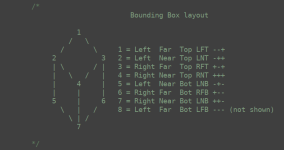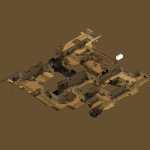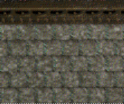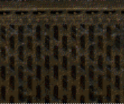dileepvr
New member
I've been trying to parse the C++ code from the old Pentagram team: https://pentagram.sourceforge.net/download.php
And I came across this comment block at the beginning of a file:

This convinced me that the whole map is tile based and all the collision boxes are cuboids.
Now we already know how to extract sprites from the game files. And the pentagram code (and others on this form) know how to read level data as well. Given that there are extant open file formats for 3D levels with great open source level editors, shoudln't it be easy to programmatically read the old game files and spit out a simple map file that can be read by these 3D level editors? Start with assuming that everything is a cuboid and worry about modelling and texturing later?
Suggestion: The Quake or GoldSrc (Half-Life 1) formats. These formats have great level editor tools like Trenchbroom and JACK. Trenchbroom has really good documentation and tutorials. And JACK is said to be really fun to work with. Not that that matters at this stage. The task is to write code to translate levels into something that these programs can read. Again, everything can be a cuboid to begin with. Save the modeling and texturing for later (and for others?)
The twitter bot BSP_overviews keeps autogenerating isometric views of GoldSrc maps and posting them twice a day. Example:

And someone has made an isometric mod to one of those open source quake engines.
So there is potential here for an eventual full port. And there will be reduced risk of the project dying prematurely due to a drop in interest as everything uses extant open tools and progress can be modular. New teams can simply pick up where the old one leaves things off.
I can start working on the basic cuboidal translator code end of Summer 2024, unless someone else wants to beat me to it.
And I came across this comment block at the beginning of a file:

This convinced me that the whole map is tile based and all the collision boxes are cuboids.
Now we already know how to extract sprites from the game files. And the pentagram code (and others on this form) know how to read level data as well. Given that there are extant open file formats for 3D levels with great open source level editors, shoudln't it be easy to programmatically read the old game files and spit out a simple map file that can be read by these 3D level editors? Start with assuming that everything is a cuboid and worry about modelling and texturing later?
Suggestion: The Quake or GoldSrc (Half-Life 1) formats. These formats have great level editor tools like Trenchbroom and JACK. Trenchbroom has really good documentation and tutorials. And JACK is said to be really fun to work with. Not that that matters at this stage. The task is to write code to translate levels into something that these programs can read. Again, everything can be a cuboid to begin with. Save the modeling and texturing for later (and for others?)
The twitter bot BSP_overviews keeps autogenerating isometric views of GoldSrc maps and posting them twice a day. Example:

And someone has made an isometric mod to one of those open source quake engines.
So there is potential here for an eventual full port. And there will be reduced risk of the project dying prematurely due to a drop in interest as everything uses extant open tools and progress can be modular. New teams can simply pick up where the old one leaves things off.
I can start working on the basic cuboidal translator code end of Summer 2024, unless someone else wants to beat me to it.



